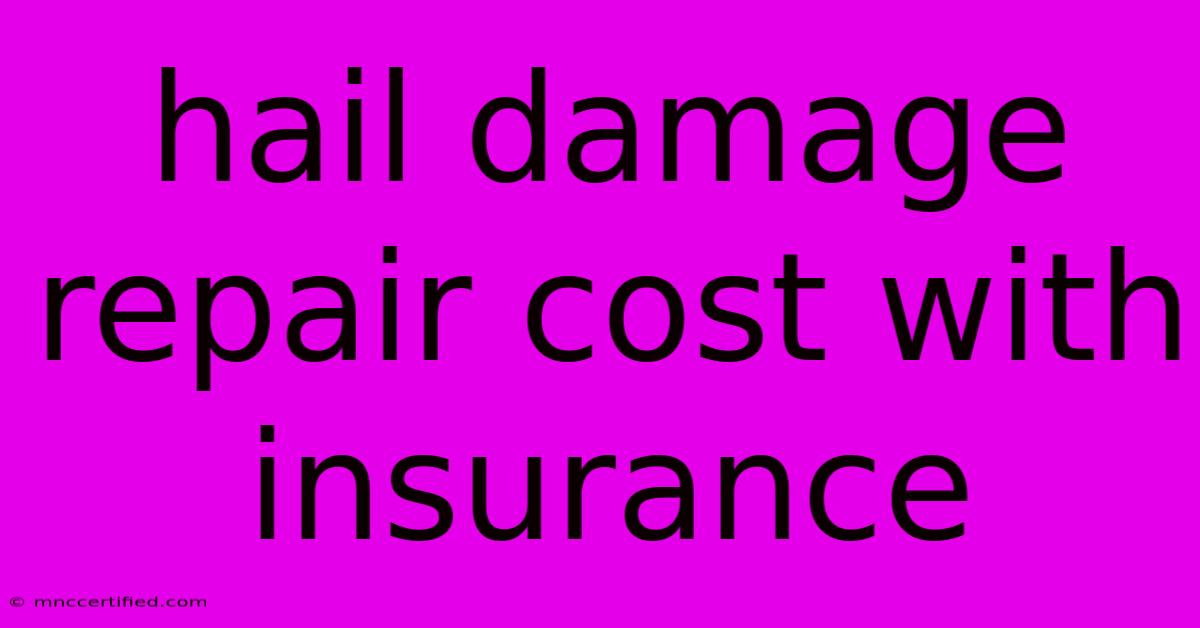Hail Damage Repair Cost With Insurance

Table of Contents
Hail Damage Repair Cost: What to Expect and How Insurance Can Help
A sudden hailstorm can leave your car looking like it's been through a warzone. The damage can be substantial, and you're left wondering how much it will cost to fix and how your insurance will help. This guide will break down the costs of hail damage repair, how insurance works, and what to do if you're facing this situation.
Understanding Hail Damage Repair Costs
The cost of hail damage repair can vary widely depending on several factors:
- Severity of the damage: Minor dents and dings will be less expensive to fix than significant damage like cracked windshields, crushed roofs, or dented hoods.
- Make and model of your vehicle: Some vehicles are more expensive to repair due to specialized parts or intricate designs.
- Location: Repair costs can vary depending on labor rates and availability of parts in your region.
- Repair method: Repair shops may offer different repair methods, such as paintless dent removal (PDR), traditional bodywork, or a combination of both.
Expect to pay anywhere from a few hundred dollars for minor repairs to several thousand dollars for extensive damage.
Insurance Coverage for Hail Damage
Comprehensive auto insurance covers damage to your car from events outside of an accident, including hailstorms. This coverage will typically pay for repairs or replacement of your vehicle, minus your deductible.
Here's what you need to know about insurance coverage:
- Deductible: Your deductible is the amount you pay out-of-pocket before your insurance kicks in. Higher deductibles mean lower premiums, but you'll pay more upfront.
- Coverage limits: Your policy will have a limit on the amount your insurance company will pay for repairs. If the damage exceeds this limit, you'll be responsible for the remaining costs.
- Filing a claim: If you have comprehensive coverage, report the hail damage to your insurance company as soon as possible. They will send an adjuster to assess the damage and determine the cost of repairs.
Important Note: If your car is totaled due to hail damage, your insurance company will pay the actual cash value (ACV) of your vehicle, minus your deductible. ACV is the current market value of your car, which is typically less than what you paid for it.
Tips for Dealing with Hail Damage and Insurance
- Take photos and videos: Document the damage to your car, including close-ups of dents and any other visible damage. This documentation will be useful when you file a claim.
- Contact your insurance company: Report the hail damage to your insurance company as soon as possible. This helps expedite the claims process.
- Get multiple estimates: Obtain quotes from several reputable body shops to ensure you're getting a fair price for repairs.
- Negotiate with your insurer: If you believe the estimate from your insurance company is too low, don't be afraid to negotiate for a higher payout.
- Consider PDR: Paintless dent removal (PDR) is a technique that can repair minor dents without repainting, often saving you money and time. Ask your body shop if PDR is an option.
Protecting Yourself from Future Hail Damage
While you can't control the weather, you can take steps to minimize the risk of future hail damage:
- Invest in a car cover: A car cover can protect your vehicle from hail and other weather elements.
- Park your car in a garage: The best way to protect your car from hail is to park it in a garage whenever possible.
- Consider a hail-resistant vehicle: Some newer car models offer hail-resistant features, such as reinforced roofs and stronger panels.
Remember: Dealing with hail damage can be stressful, but staying organized, understanding your insurance policy, and getting multiple estimates can help you navigate the process more effectively and ensure you receive fair compensation for repairs.

Thank you for visiting our website wich cover about Hail Damage Repair Cost With Insurance. We hope the information provided has been useful to you. Feel free to contact us if you have any questions or need further assistance. See you next time and dont miss to bookmark.
Featured Posts
-
Liverpool Hope For Zoes Place
Nov 09, 2024
-
Insurance Coverage For Private Schools
Nov 09, 2024
-
Rapper Bhad Bhabie Diagnosed With Cancer
Nov 09, 2024
-
Balsam And Fir Trading Company Website
Nov 09, 2024
-
Londons Lord Mayors Show A Guide
Nov 09, 2024